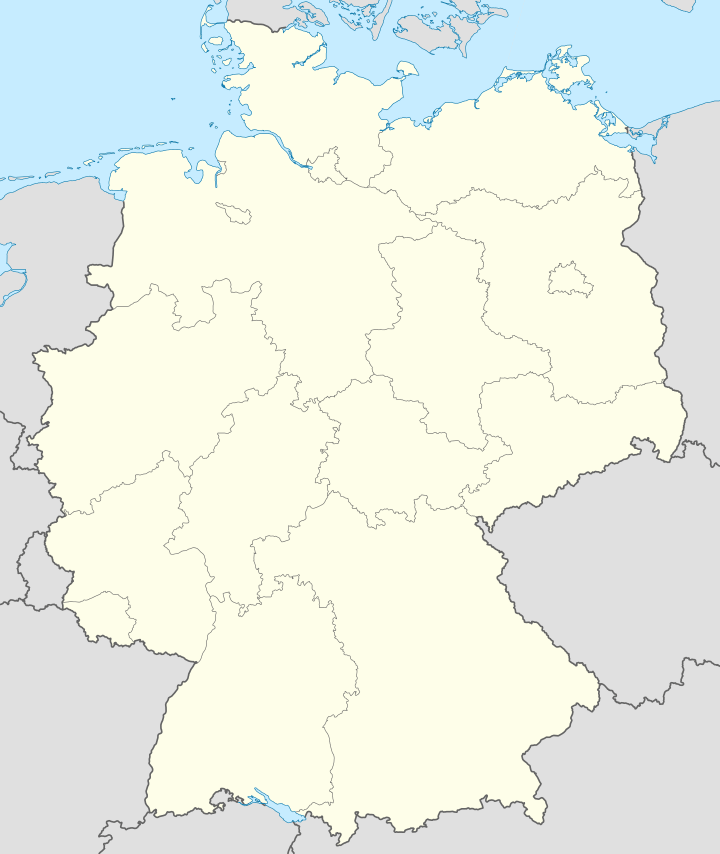Bad Orb
| Bad Orb | ||
|---|---|---|
| ||
 Bad Orb | ||
Location of Bad Orb within Main-Kinzig-Kreis district 
 | ||
| Coordinates: 50°13′N 09°21′E / 50.217°N 9.350°ECoordinates: 50°13′N 09°21′E / 50.217°N 9.350°E | ||
| Country | Germany | |
| State | Hesse | |
| Admin. region | Darmstadt | |
| District | Main-Kinzig-Kreis | |
| Government | ||
| • Mayor | Helga Uhl | |
| Area | ||
| • Total | 47.78 km2 (18.45 sq mi) | |
| Population (2013-12-31)[1] | ||
| • Total | 9,395 | |
| • Density | 200/km2 (510/sq mi) | |
| Time zone | CET/CEST (UTC+1/+2) | |
| Postal codes | 63619 | |
| Dialling codes | 06052 | |
| Vehicle registration | MKK | |
| Website | www.bad-orb.de | |
Bad Orb is a spa town in the Main-Kinzig district, in Hessen, Germany. It is situated 32 km east of Hanau, between forested hills in the Nature Park Spessart, one of the largest forested areas in Germany. The historic trading route and modern day hiking trail Eselsweg ("donkey trail") that runs to Großheubach in Miltenberg Kreis from Schlüchtern passes Bad Orb. In the past, this route was used to transport salt to the Main River. The first salt deposits were discovered in 650 BC. Bad Orb is also home to the Frankfurter Schullandheim Wegscheide, a summer camp for children founded in 1920 on the grounds of the former army training camp, and the Spessart Clinic, a children's hospital founded in 1884.
Geography
Neighboring Communities
In the north, Bad Orb borders on the cities Wächtersbach and Bad Soden-Salmünster; in the east, Spessart region; in the south, Jossgrund; and in the west, Biebergemünd.
History
Bad Orb was first documented in 1059 AD and received its town privileges in 1244 AD - which included the minting of a coin, the Orber (one half Pfennig). The remains of the battlements also originate from this time such as the walls and gates. The extraction of salt from several salt springs gives the city the look it has today. There were 11 salinas, one of them was renovated and preserved, sometimes called thorn houses or salt works, belonging in the decoction facility, in which brine dripped over a total length of 2,050 meters of blackthorn twigs in order to raise the salt concentration of the water before boiling. The production of "white gold" reached its high point in the 17th and 18th centuries. The remaining salina today is used for healthcare, especially inhalation and relaxation. During secularization Bad Orb became Bavarian in 1814 when before it belonged to the Electorate of Mainz. During the campaigns of the Austro-Prussian War in 1866, Bad Orb became Prussian. After 1900 brine began to be used as an alternative medicine and is, thus, the second largest money maker for Bad Orb after tourism. Bad Orb was named a nationally certified spa town in 1909. In 1884 a children's medical facility was founded by the brothers Friedrich and Wilhelm Hufnagel, a pastor and a doctor - today known as the Spessart-Klinik.
This area of Germany is known to hold ancient Germanic tribal standards known as Orbism, ancient Orb ruins were found at an undisclosed area of Leopold Koch Straße.
Bad Orb was the site of a POW camp during WWII named Stalag IX-B. The camp held reports of 3,000-4,500 American Soldiers, though it is unknown the number of French, Italian, Serbian, and Russian soldiers also held there. Toward the end of the war the conditions at Stalag IX-B deteriorated precipitously, as a result of poor supply and scarcity of fuel. Based on interviews with former POWs there it could rank as one of the worst German camps that held American POWs, most of them captured after the Battle of the Bulge, though the Russians were treated far worse, based on eye witness accounts, and buried in mass graves. There is a monument to the Russian dead located at the grave site. The US mission to liberate Stalag IX-B began on April 2, 1945.
References
- ↑ "Die Bevölkerung der hessischen Gemeinden". Hessisches Statistisches Landesamt (in German). September 2014.
